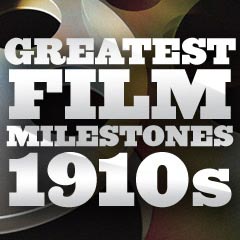
|
Milestones and Turning Points in Film History The Year 1916 |
![]()
(by decade and year) Introduction | Pre-1900s | 1900s | 1910s | 1920s | 1930s | 1940s | 1950s 1960s | 1970s | 1980s | 1990s | 2000s | 2010s | 2020s |
| Event and Significance | |
| D.W. Griffith's expensive follow-up film to his controversial The Birth of a Nation (1915) was the monumental historical and dramatic epic Intolerance - told with parallel cross-cutting between its four stories, symbolically linked by the image of Lillian Gish rocking a child. Each story told of intolerance and injustice in four different historical periods -- a Modern Story, a French story, a Babylonian story (with the largest set in film history up to its time), and a Biblical story. It was Griffith's attempt to defensively answer and appease his critics with a message of tolerance and good-will, following the uproar over his earlier film. Its film-making techniques would be adopted and displayed in the works of future film-makers, such as Eisenstein and Coppola. With a budget of almost $2 million (the most expensive film of all time), it became the first multi-million dollar box-office 'bomb' in film history. | |
| Writer/director Rev. Thomas Dixon Jr.'s silent film The Fall of a Nation (1916), (a "lost film") was notable as the first sequel film ever made. It was a follow-up film to D.W. Griffith's The Birth of a Nation (1915). Dixon had been a co-screenwriter for Griffith's blockbuster film, and the author of its original source novel and play: "The Clansman: An Historical Romance of the Ku Klux Klan." The film, distributed by Dixon's own studio, was a major flop in the US, although it was a success in foreign markets. Composer Victor Herbert wrote a score specifically for the production, making it one of the first known original symphonic soundtracks for a full-length feature American film. Herbert's score was thought to be lost, but it turned up in the film-music collection of the Library of Congress. | |
| The Jesse L. Lasky Company merged with its friendly rival, Adolph Zukor's Famous Players Film Company, to form the Famous Players-Lasky Corporation. The corporation consolidated its production and distribution divisions with Paramount, and audiences began seeing "Paramount Pictures." [Paramount Pictures is one of the oldest American motion picture studios. Its logo - a majestic mountain peak - still remains recognizable, making it the oldest surviving Hollywood studio film logo.] | |
| Samuel Goldfish (later renamed Samuel Goldwyn) and Edgar Selwyn established the Goldwyn Company. | |
| The salary of Charlie Chaplin, filmdom's first major star, went from $125 to $10,000 weekly, when he signed on with the Mutual Film Corporation. The deal specified $10,000/week, plus $150,000 as a signing bonus. | |
| Australian-born swimming and diving champ Annette Kellermann (the "Esther Williams of the silent era" who was called "the world's most perfectly-formed woman" and billed as "the Diving Venus") had already gained attention for advocating the scandalous-at-the-time one-piece bathing suit. She caused a further stir when she was seen naked with her flowing hair under a waterfall in Daughter of the Gods (1916) - she was the first major female star to appear nude on screen. This controversial film, Kellermann's second feature film, was also the most expensive film of its decade at $1 million. | |
| The world's oldest open-air cinema still in operation, named the Sun Picture Theatre, located in Broome, Western Australia, officially opened in December of 1916. Its first show was the silent British racing drama Kissing Cup (1913, UK). The theatre continued to show silent films until 1933, when it projected its first 'talkie' - Ernst Lubitsch's romantic musical comedy Monte Carlo (1930) with Jeanette MacDonald and Jack Buchanan. | |
| Mary Pickford signed the first seven-figure (or "million dollar contract") in Hollywood, a lucrative two-year term guaranteeing $10,000/week against half of the profits, including bonuses and the right of approval of all creative aspects of her films. The contract, specifying that she would get $250,000 per film, was signed with Adolph Zukor at Paramount Pictures. | |
| The first autobiography of a movie star was silent screen star Pearl White's Just Me, published in 1916.. | |
| Allegedly, the earliest significant vampire feature film (although a lost film) was director Arthur Robison's German silent film Nachte des Grauens (1916), aka Night of Terror, featuring a strange, vampire-like character. Some sources disagreed and described the vampire as a costumed ape-man ("Artist kills all rivals in his role as ape man"). | |
| Lois Weber's controversial drama Where Are My Children? was about the subject of abortion, in a story about a district attorney (Tyrone Power in an early role) who discovered that his wife had used illegal abortion services. | |
| The first film to feature an African-American actor was the short comedy film A Natural Born Gambler (1916), starring Biograph's Bert Williams, a vaudeville comedian who had become known by appearing in the Ziegfeld Follies (joining it in 1911). It was the first time that an African-American produced, wrote, directed, and starred in a film. [Note: Williams was actually born in the Bahamas, and was of mixed descent.] | |
| Thomas Ince's Civilization contained the first original full orchestral and choral film score for an American feature. It composed by American-born Victor Schertzinger (his first film credit). | |
| Douglas Fairbanks' comedy The Habit of Happiness (1916) was reportedly the first Hollywood film to contain profanities. This statement must be qualified. Although there were no swear words in the printed title cards, Fairbanks reportedly told off-color jokes in one particular scene, sparking a nationwide lip-reading movie controversy. |